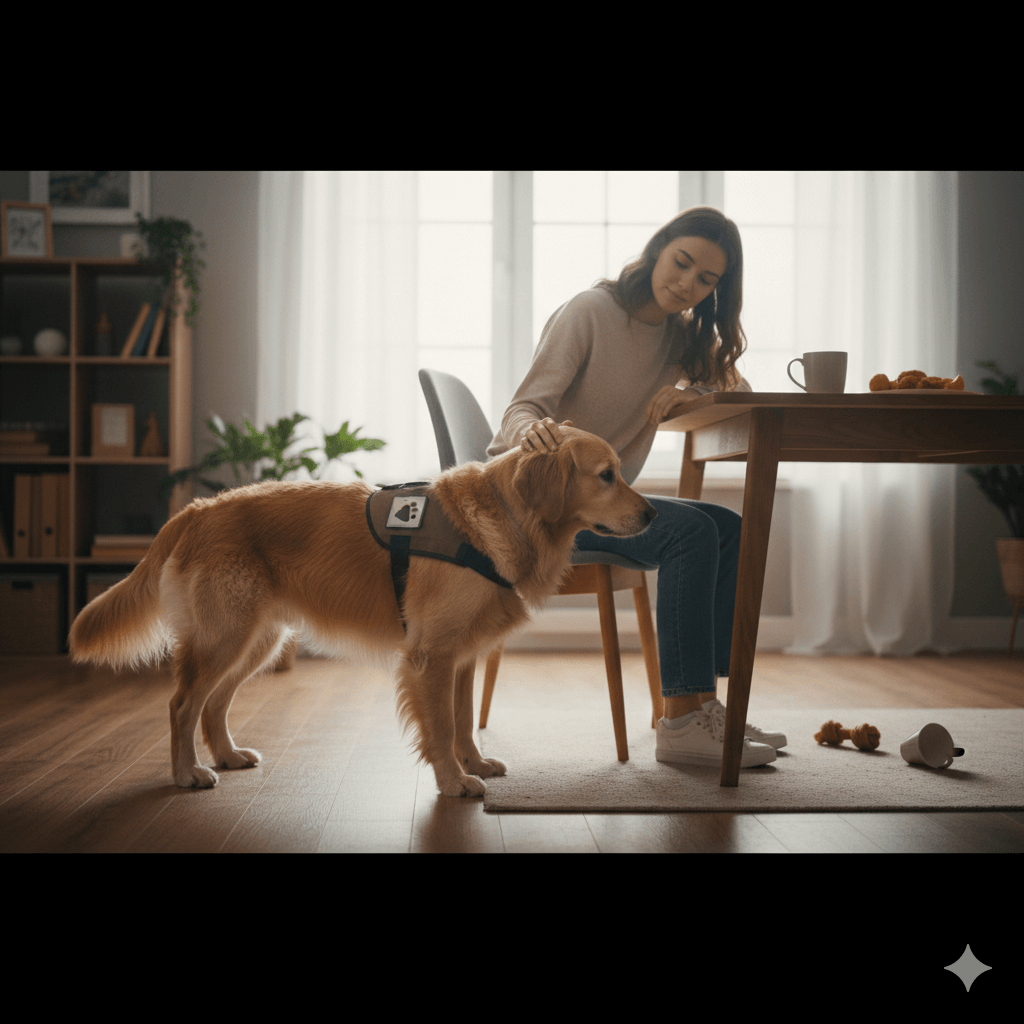Why Does My Dogs Hair Stand Up? Understanding the Mystery Behind It
Have you ever noticed your dog’s hair suddenly standing on end, like a tiny porcupine ready to face the world? This phenomenon, often referred to as “raised hackles” or “piloerection,” is more than just a quirky trait—it’s a window into your furry friend’s emotional and physical state. Whether it’s during a tense encounter at the dog park or simply when they hear an unfamiliar sound, this reaction can tell us a lot about how our dogs are feeling. In this blog post, we’ll dive deep into why this happens, what triggers it, and how you can help your pup feel more comfortable. Let’s unravel the mystery behind your dog’s hair standing up!
Common Triggers for Raised Hackles in Dogs
Dogs communicate through body language, and raised hackles are one of their most expressive signals. While it may look dramatic, it’s important to understand that this response isn’t always a cause for concern. Below are some common reasons why your dog’s hair might stand up:
Fear or Anxiety:
Raised hackles can indicate that your dog feels threatened or scared by something in their environment.Excitement or Anticipation:
Sometimes, dogs get so excited about playtime or meeting new friends that their hackles involuntarily rise.Aggression or Defensive Behavior:
In situations where your dog perceives a threat, raised hackles may be part of their defensive posture.Surprise or Startle Reflex:
A sudden loud noise or unexpected movement can trigger this reaction as part of their instinctive response.Health Issues:
Occasionally, medical conditions such as skin allergies or infections could cause persistent piloerection.
Understanding these triggers can help you better interpret your dog’s behavior and respond appropriately. Remember, raised hackles alone don’t necessarily mean aggression—they’re just one piece of the puzzle!
How to Identify Raised Hackles vs. Other Physical Signs
While raised hackles are easy to spot, they’re often accompanied by other subtle cues that provide context. Learning to differentiate between these signs will help you gauge your dog’s overall mood and well-being. Here’s what to look out for:
Body Posture:
Pay attention to whether your dog’s body is stiff and rigid or relaxed and loose.Tail Movement:
A wagging tail doesn’t always mean happiness; the speed and height of the wag offer additional clues.Facial Expressions:
Ears pinned back, widened eyes, or a closed mouth can signal discomfort or tension.Vocalizations:
Growling, barking, or whining may accompany raised hackles depending on the situation.Breathing Patterns:
Rapid panting or shallow breathing can indicate stress or excitement.
By observing these accompanying behaviors, you’ll gain a clearer picture of what your dog is trying to communicate. Context matters—always consider the bigger picture before jumping to conclusions!
Check this guide 👉Why Does My Dog Gag After Drinking Water? Best 7 Tips!
Check this guide 👉Why Does My Dog Pee on My Other Dog? Best 7 Behavior Tips!
Check this guide 👉Why Doesnt My Dog Listen to Me? Best 7 Behavior Tips!

Physical Signs to Watch For | Possible Emotional States |
|---|---|
Raised hackles | Fear, excitement, aggression |
Stiff body posture | Alertness, defensiveness |
Tail tucked under | Submissiveness, fear |
Ears flattened against the head | Anxiety, submission |
Excessive drooling | Nervousness, anticipation |
Tips to Help Calm Your Dog When Their Hackles Are Raised
Seeing your dog’s hackles rise can be alarming, but there are several ways you can help them relax. These calming techniques focus on reducing stressors and creating a safe environment. Try these strategies next time you notice your dog’s hair standing up:
Remove Them from the Situation:
If possible, gently guide your dog away from whatever triggered the reaction.Use Positive Reinforcement:
Reward calm behavior with treats or praise to reinforce a sense of safety.Practice Desensitization:
Gradually expose your dog to mild versions of their triggers to build confidence over time.Provide a Safe Space:
Create a cozy corner or crate where your dog can retreat when feeling overwhelmed.Engage in Play or Distraction:
Redirect their attention with toys or games to shift their focus away from the trigger.
These methods won’t eliminate raised hackles entirely, but they can reduce the frequency and intensity of episodes. Patience and consistency are key!
When to Consult a Veterinarian About Raised Hackles
While occasional piloerection is normal, persistent or unexplained instances could warrant professional advice. If your dog’s hair frequently stands up without any apparent reason, it might be worth consulting a vet. Consider these scenarios:
Chronic Skin Irritation:
Redness, itching, or flaky skin alongside raised hackles could indicate dermatological issues.Behavioral Changes:
Sudden shifts in temperament or unusual reactions may point to underlying health problems.Unexplained Aggression:
If your normally friendly dog becomes aggressive, seek expert guidance promptly.Frequent Episodes:
Regular occurrences despite no clear triggers should not be ignored.Accompanying Symptoms:
Lethargy, loss of appetite, or vomiting combined with raised hackles requires immediate attention.
Your veterinarian can rule out medical causes and suggest behavioral interventions if needed. Early intervention ensures your dog stays happy and healthy!
Understanding the Role of Environment
The environment plays a significant role in influencing your dog’s behavior, including raised hackles. From loud noises to unfamiliar surroundings, external factors can trigger this reaction. Here are some environmental elements that might cause your dog’s hair to stand up:
Loud Noises:
Thunderstorms, fireworks, or construction sounds can startle your dog and lead to piloerection.Unfamiliar People or Animals:
Meeting new people or encountering strange animals may provoke uncertainty and defensive reactions.Crowded Spaces:
Busy dog parks or crowded streets can overwhelm sensitive dogs, causing stress-related responses.Sudden Changes in Routine:
Moving houses, traveling, or altering daily schedules can disrupt your dog’s sense of security.Weather Conditions:
Extreme temperatures or sudden weather changes might make your dog uneasy.
By identifying and minimizing exposure to these triggers, you can help your dog feel more at ease. A stable and predictable environment fosters confidence and reduces unnecessary reactions.
Signs That Raised Hackles Are Linked to Health Issues
While raised hackles are often behavioral, they can sometimes signal underlying health problems. If your dog’s piloerection seems excessive or unrelated to their surroundings, it’s worth investigating further. Below are potential health-related causes to consider:
Skin Allergies:
Allergic reactions to food, pollen, or cleaning products can irritate the skin and cause involuntary hair-raising.Parasites:
Fleas, ticks, or mites may lead to constant itching and irritation, triggering raised hackles.Hormonal Imbalances:
Conditions like hypothyroidism or Cushing’s disease can affect your dog’s coat and overall comfort.Nerve-Related Disorders:
Issues with the nervous system might result in abnormal muscle contractions, including piloerection.Infections:
Bacterial or fungal infections on the skin can cause discomfort and frequent episodes of raised hackles.
If you suspect a health issue, consult your veterinarian promptly. Early diagnosis and treatment can prevent complications and improve your dog’s quality of life.
Building Trust to Reduce Stress Reactions
Building trust with your dog is essential for reducing stress-related behaviors, including raised hackles. When your dog feels safe and secure, they’re less likely to react defensively or anxiously. Here are some ways to strengthen your bond and promote calmness:
Consistent Training:
Regular obedience training helps your dog understand expectations and builds mutual respect.Positive Association:
Pair potentially stressful situations with rewards to create positive associations over time.Routine Walks:
Daily walks not only provide exercise but also reinforce your role as a reliable leader.Gentle Handling:
Approach your dog calmly and avoid sudden movements to maintain their sense of safety.Quality Time Together:
Spend one-on-one time playing, grooming, or simply relaxing to deepen your connection.
A strong bond creates a foundation of trust, helping your dog navigate the world with confidence. By investing in your relationship, you’ll see fewer instances of stress-related behaviors like raised hackles.
Frequently Asked Questions About Dog Hair Standing Up
Is it normal for my dog’s hair to stand up occasionally?
Yes, occasional piloerection is completely normal and usually tied to emotional responses.
Can I train my dog to stop raising their hackles?
You can’t stop the involuntary reaction itself, but training can address the root causes like fear or anxiety.
Does raised hackles always mean my dog is angry?
No, raised hackles can signify various emotions, including excitement, fear, or surprise.
Should I punish my dog for growling when their hackles are raised?
Punishment can worsen anxiety. Instead, focus on identifying and addressing the source of their discomfort.
What should I do if my dog’s hackles stay raised all day?
Persistent piloerection could indicate a medical issue. Consult your vet for a thorough check-up.
Understanding and Supporting Your Dog Through Raised Hackles
In conclusion, while seeing your dog’s hair stand up might initially seem alarming, it’s simply their way of expressing emotions. By paying close attention to their body language and learning to interpret the context, you can strengthen your bond and ensure your furry companion feels secure. Whether it’s through calming techniques, professional guidance, or simply providing love and reassurance, you have the power to make a difference. So the next time your dog’s hackles rise, take a moment to observe, empathize, and act accordingly—it’s all part of being the best pet parent you can be!
Understanding Bone Supplement for Cats: Best 7 Expert Tips! – Safe, vet-approved guidance for strong feline bones & balanced nutrition.
Bone Supplement for Dogs: Best 7 Expert Tips! – Expert guide to calcium, collagen & bone health for every life stage.
Understanding Can Cats Get Sunburn: Best 7 Expert Tips! – Protect your feline from UV damage with vet-backed prevention strategies.
How to Train a Seizure Alert Dog: Best 7 Expert Tips! – Learn expert-backed steps to nurture natural instincts into reliable, life-saving seizure alerts.





